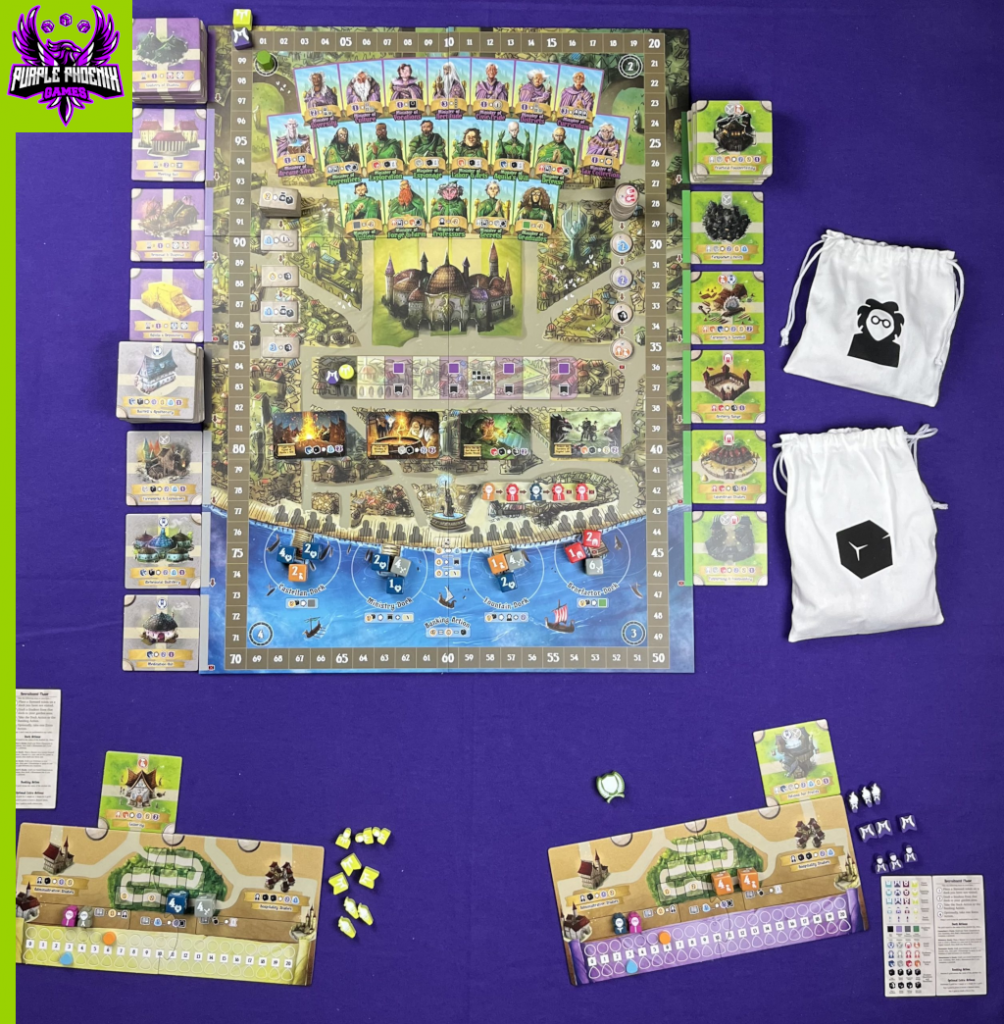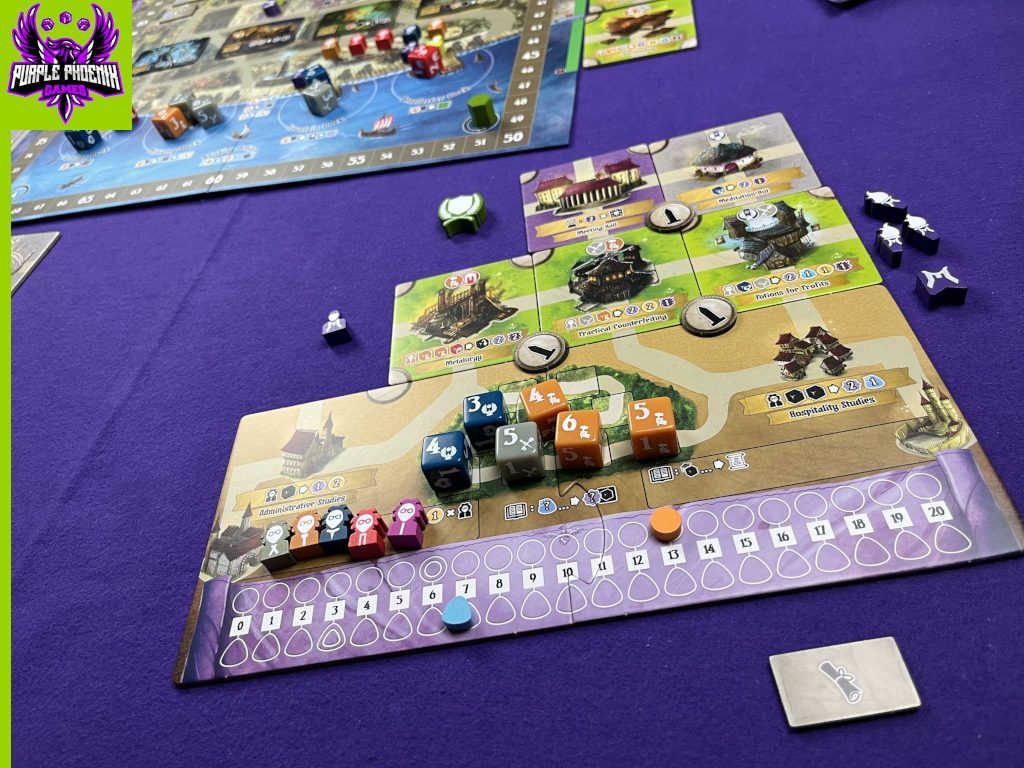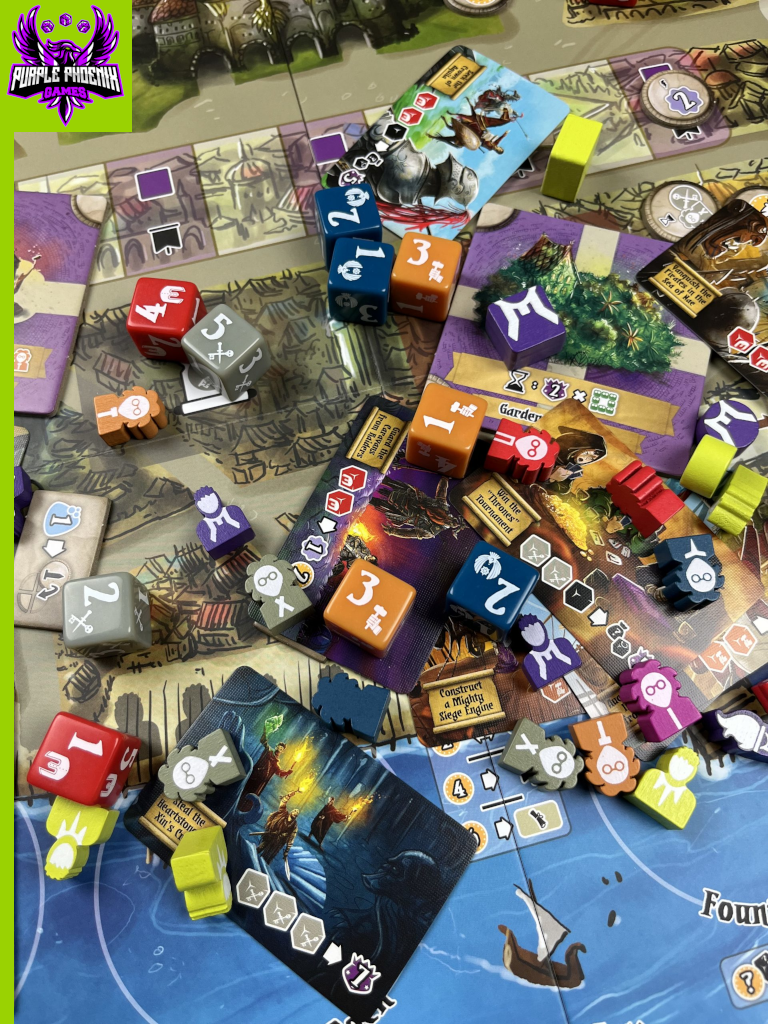
I know I say it every time we do a Valeria game, but I never get tired of this game universe. There’s a sense of familiarity, having played other Valeria games, but a unique difference to each and every one. So when Guild Academies of Valeria showed up at my door, I was excited to see what was in store. And get ready, because there’s a lot going on in this one!
| Guild Academies of Valeria (2023) | Daily Magic Games |
| 1-4 players | 90-120 minutes |
| Ages 14+ | BGG Weight – 3.40 / 5 |
In Guild Academies of Valeria, players take on the roles of Headmasters in the midst of building their individual Academies in the Valerian realm. You must: build classrooms on your campus, hire guild masters to be Professors, recruit Students to study at your Academy, influence the Council Members of your town to benefit your Academy, and send your Graduates on Quests for the King. Can you seamlessly juggle all of those tasks to show that your Academy is the greatest in Valeria? Or will you and your Academy falter? Only one way to find out…
Disclaimer: We were provided with a copy of this game for the purposes of this preview. What you see pictured below is a retail version of the game. I do not intend to rehash the entire rulebook, but rather provide a general overview of the rules and gameplay. For a more in-depth look, pick up the game from the publisher or your FLGS! -L
Guild Academies of Valeria is a game of worker-/dice-placement and drafting game in which players are trying to amass the most end-game Victory Points (VP). The game is played over a series of 4 rounds, with some elements played in turn order and others played simultaneously. There is quite a bit of setup to do, so I’ll give a brief rundown. Check out the rulebook for the specifics.
To setup for a game, set the game board in the center of the play area. Shuffle and place the Prestige tiles, Town Classroom tiles, Guild Classroom tiles, Monument chits, and Favor chits as described in the rulebook, face-up in their respective places on the board. Sort the Quest cards by Guild and arrange them by VP (lowest to highest) on their places on the board. Depending on the player count, fill the Professor and Student (dice) draw bags, and randomly draw and fill their respective draft areas on the board. Each player receives a Player Board and components in their chosen color. Set your Resource trackers to their Starting Positions, draw 2 random Student dice from the bag, set them to 4 and place them on your Player Board, and take a random Guild Classroom tile to start your Academy. Select a starting player, and the game is ready to begin! Pictured below is the setup for a 2-player game.

The game is played over 4 rounds, and each round is broken down into 4 phases: Recruitment, Education, Questing, and Restoration. In the Recruitment phase, players will be drafting Student dice to their player boards. This phase is played in turn order, beginning with the starting player. On your turn, you will place one of your Steward tokens onto an unoccupied Steward space on one of the 4 docks on the board. Each dock houses a number of Student dice for this round, and each dock grants you a unique action. When you place your Steward, choose one of the Student dice from that dock and place it on your Player Board. You then must perform the action associated with your dock, or take the Banking action. The different docks allow you to draft Classroom tiles or Professors to your Academy, or move Banners amongst the Council Members (giving you powerful in-game abilities, or additional opportunities for end-game scoring). The Banking action allows you to gain Gold for use in later phases. Additionally, you can take one additional (and optional) Extra Action. The Extra Actions allow you to trade Resources, or pay to gain Favors or move Banners. Taking no action in this phase is not allowed. Once you have placed a Steward, drafted a die, and performed the appropriate Action(s), play moves to the next player. This phase continues until all players have placed all 3 of their Stewards.
Next, we move to the Education phase, which is played simultaneously. In this phase, players will be moving Professors and Student dice from their Player Board to fill the Classroom tiles in their Academies. Most Classrooms have requirements for placement, whether they be color of Professor/Student dice, or number values on the dice. You must be able to completely fill a Classroom’s requirements to place Professors/Students there this round. When you have filled a Classroom’s requirements, you then gain the rewards listed on that Classroom tile. You can gain Resources (Gold or Magic), VP (immediately added on the VP tracker), or you can gain Knowledge (allows you to manipulate dice in the Classroom). Each point of Knowledge can be used to raise the value of Student dice in the corresponding classroom. Once a Student die would be raised to a value of 7 or higher, it is considered to ‘Graduate’ and is placed on the Graduation Stage of the Player Board. Only Graduate dice can go on Quests (in the next phase), so Graduating is what all Students should be striving to achieve! When all players have placed their Professors/Students and processed the appropriate rewards, this phase ends.
The Questing phase comes next, and is played simultaneously as well. Players take a look at the available Quest cards on the game board. Like the Classroom tiles, Quests have requirements for placement – only certain Graduate dice can fulfill different Quests. For each Quest you can fulfill, place a Torch token on the corresponding cards, and move the used Graduate dice off to the side. For each Quest you complete, gain the corresponding reward from the Quest Card, and move your Quest tracker accordingly, gaining any rewards there as well. Multiple players can complete the same Quest card each round. Once all players have completed the Quests they can/want to, this phase ends.
If, after the Questing phase, it is not yet the fourth round, move to the Restoration phase. Here, you will clean-up and prepare for the next round. Discard specific Favor/Monument chits, as well as certain Classroom/Prestige tiles and Professors from their respective rows, filling in the now-empty spaces as needed. Discard all remaining Student dice on the Docks, and re-roll new ones for the next round. Replace Quest cards if needed. Take all remaining Student dice and Professors from your Academy (Classroom tiles on your player board) and bring them back to your player board starting areas. Give the starting player token to the next clockwise player, advance the Round tracker, and the new round is ready to begin. If, after the Questing phase, this is the fourth round, you move to end-game scoring. Tally up any remaining points from end-game scoring tiles/chits and Banner placement on Council Members. Total up your score, and the player with the most VP is declared the winner!

At the time I am writing this, I think the ‘heaviest’ Valeria game I had played was Margraves of Valeria. But Guild Academies of Valeria has definitely overtaken it as the most involved Valeria game I have played. There is quite a lot going on here – but that’s not necessarily a bad thing! The strategy of this game is through the roof. There are so many moving pieces to consider, you have to constantly be on the ball in order to maximize your VP possibilities. And you have to keep your strategy fairly adaptable, in case an opponent slips in and takes a Student die/Professo/Classroom tile that you were vying for. You’re constantly trying to plan turns in advance, as so many elements of the game rely on others. For example, you can’t fill a Classroom without the right Professors and Student dice. You really have to play the long game here, and it may or may not pay off.
One thing that is a saving grace for the complexity of the gameplay is that most of the game is played simultaneously, meaning you’re not just sitting around waiting for your turn. You’re constantly engaged, since you’re pretty much playing 100% of the time. That being said, the game takes a little bit of time to really get going. It’ll take a few turns (or I would argue an entire round) to really set up your strategy. Yes, you start with 2 random Student dice and a random Classroom tile, but if they don’t all correspond, you really are starting from zero. And it can be a bit overwhelming deciding which strategy to take your first few games. My first time, I was overambitious and was trying to dabble in pretty much every route possible – collecting as many Favor/Monument tokens as possible, but also trying to build as many Classrooms as possible, and somehow also trying to get the right Professors/Student dice to fill those Classrooms. It was a lot, and it really didn’t work for me. The more I play, though, the more I’ve figured out that you kind of have to pick one route and hit it hard. You can (and should!) also branch into other strategies, but you’ve got to pick one main strategy and stick to it. There definitely is a learning curve, so I would say you’ve got to get at least 3 games in before you can really get a feel for if it’s a good game for you. As someone who doesn’t play too many ‘heavy’ games, it took me a bit to get into, but once I got a feel for how it all works together, I was sold!
I’ll touch briefly on components here. As always with every Daily Magic Games game I’ve encountered, the production quality is excellent. The boards, chits, and tiles are nice and thick cardboard, that will definitely hold up. The little wooden Professors are a cute design, and I like the print on them instead of just leaving them blank. The Student dice are uniquely designed, and are nice quality dice overall. The artwork (once again by the Mico) is awesome and always gets me excited for any Valeria game. The iconography used is seen in most of the Valeria games, so understanding it wasn’t hard for me – it may be a bit more challenging to pick up for someone who has never played a Valeria game before. The game does come with thorough turn reference tiles for players, as well as tiles that outline every symbol and its meaning, so that helps a ton! All in all, another great game from Daily Magic Games.
As I admitted earlier, I’m not really big into ‘heavy’ games. I love a good strategy, but I generally like a more simple and direct approach. That being said, the more I play Guild Academies of Valeria, the more the game grows on me. My first play, I was totally overwhelmed. The next, I felt a tad more successful, even though my end-game score was still feeble. The next game, I had a stronger grasp on what it takes to win. And so on and so forth. Maybe I just need to give heavier games more time to really settle in for me, because that’s what has happened with this game. As a fan of the other Valeria games, I was wary how this one would fare for me. But the more I play it, the more I like it. If you’re big into heavy games, definitely give this one a shot! It really gets the gears grinding in your head, and will burn your brain all the way til the end. But it’s worth it! And if you’re more like me and aren’t so sure about heavy games, I’d still recommend this one. It may take a few more plays to wrap your head around it, but once you do, you’ll find a really neat and unique game. With so many moving elements, you’ll truly never play the same game twice here, and that adds to the overall enjoyment of the game. Give this one a shot – you might be pleasantly surprised at what you find!

